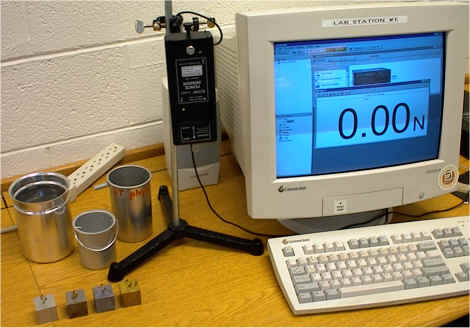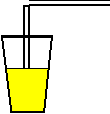















In this laboratory you will first investigate properties of fluid pressure. You will then determine the density of a metal block by applying Archimedes' principle.
Open a Microsoft Word document to keep a log of your experimental procedures, results and discussions. This log will form the basis of your lab report. Address the points highlighted in blue. Answer all questions.
Experiment
Archimedes' Principle states that an object partially or wholly immersed in a gas or liquid is acted upon by an upward buoyant force B equal to the weight w of the gas or liquid it displaces. In this experiment you will verify this by measuring the apparent loss of weight of several submerged objects and by finding the weight of the displaced fluid. You will also determine the density of the objects. A PASCO Force Sensor is used to measure the weights.

I. Verify Archimedes' principle using the data below. Click on a small picture if you want to see an enlarged picture.
| (a) | (b) | (c) | (d) | |
|---|---|---|---|---|
| Object 1: |
 |
 |
 |
 |
| Object 2: |
 |
 |
 |
 |
| Object 3: |
 |
 |
 |
 |
| Object 4: |
 |
 |
 |
 |
For each of the objects:
(a) Determine the weight Wc of the empty container with the handle. When the container is suspended from the force sensor, the force sensor measures the force of gravity (weight) acting on the object, and the program displays the magnitude of this force (in N) on the computer screen.
(b) Determine the weight of an object Wo when it is suspended above the container with the overflow spout. This container is completely filled with water, and the container with the handle standing below the spout is empty.
(c) Determine the apparent weight of the object Wow after it has been lowered into the water. As the object is lowered into the water, water pours out of the overflow spout. The container with the handle has collected this water.
(d) Determine the weight Wcw of the container with the handle holding the collected water.
Record the weights in a spreadsheet as shown below.
| Wc | Wo | Wow | Wcw | Ww | Fb | (Fb-Ww)/Fb | |
|---|---|---|---|---|---|---|---|
| Object 1 | |||||||
| Object 2 | |||||||
| Object 3 | |||||||
| Object 4 |
For each of the objects:
II. Determine the density of the objects.
Extend your Excel spreadsheet. Set up labels as shown below.
| mo | mw | Vw | ρo | material | |
|---|---|---|---|---|---|
| Object 1 | |||||
| Object 2 | |||||
| Object 3 | |||||
| Object 4 |
| Material | Density (kg/m3) |
|---|---|
| Aluminum | 2.7*103 |
| Brass | 8.7*103 |
| Lead | 11.3*103 |
| Steel | 7.9*103 |
| Water | 1.0*103 |
Log entries:
Exploration
Open the simulation Under Pressure.
The interface
Explore how the pressure in the liquid changes as a function of depth, liquid density, filling level, and external conditions. Answer the questions below, always supporting your answer with data from a measurement.
For static fluids it tells us how the pressure in a fluid column depends on the
position above the bottom where the pressure is measured.
P1 + ρgh1
= P2 + ρgh2.
For fluids in motion it it gives us a relationship between fluid pressure,
speed, and vertical position. If, for example, a liquid (or a gas which is not being compressed)
is flowing frictionless in a steady state through a horizontal
pipe with a varying cross-sectional area, then the pressure depends on the speed
of the fluid.
The faster the fluid is flowing, the lower is the pressure at the same height.
This may seem counterintuitive to you, but it is a consequence of conservation of energy. The molecules of a fluid at room temperature are always in motion, even if the fluid as a whole is at rest. This disordered motion is responsible for the pressure exerted by the fluid, even in gravity-free space. In a pipe, it results in collisions with the walls. If a fluid is flowing trough a horizontal pipe at a steady rate, then the molecules also have ordered motion. In a narrow section of the pipe the fluid is flowing faster, and more of its energy goes into the ordered motion. This leaves less energy for the random motion and therefore results in softer collisions and lower pressure.
Exercise

Record your observations and explanations in your log.
Convert your log into a lab report.
Name:
E-mail address:
Laboratory 7 Report
Save your Word document (your name_lab7.docx), go to Canvas, Assignments, Lab 7, and submit your document.